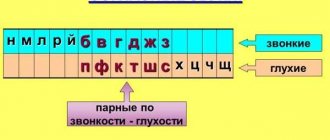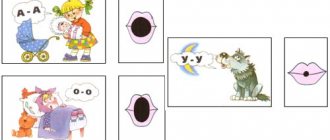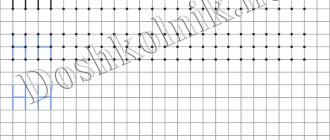- home
- Directories
- Handbook of Russian for elementary school
- Sounds and letters
- Consonant sounds and letters representing them
- Voiceless and voiced consonants
Consonant sounds can be pronounced with a greater or lesser degree of sonority. In accordance with this, voiced and voiceless consonants are distinguished.
Voiceless consonant sounds are made up of noise, while voiced consonant sounds are made up of noise and voice.
Some consonant sounds are paired in terms of voicedness and voicelessness , i.e. can be voiced or devoiced depending on their position in the word. And some are unpaired , i.e. their sound does not depend on position.
Table of consonant sounds paired and unpaired by voicedness/voicelessness:
| Groups consonants | Doubles | Unpaired |
| Voiced | [b], [b'], [c], [c'], [d], [g'], [d], [d'], [g], [h], [z'] | [th'], [p], [p'], [l], [l'], [m], [m'], [n], [n'] |
| Deaf | [p], [p'], [f], [f'], [k], [k'], [t], [t'], [w], [s], [s'] | [ts], [x], [x'], [h'], [w'] |
Consonant paired voiced sounds are deafened:
- at the end of the word - tooth b [zu p ], hundred g [hundred k ], plo v [plo f ]
- before voiceless consonant sounds - lips ki [gu p ki], spoon [ loshka ] , low [n'is ka ]
Consonant paired unvoiced sounds are voiced:
- before voiced consonant sounds - with delka [ z' d'elka], grind ba [small d' ba]
The correct spelling of paired consonants based on voicedness/voicelessness is an orthogram that requires a test word.
unpaired in terms of voicedness/voicelessness are not deafened or voiced, regardless of where in the word or before what sounds (voiced or voiceless) they are located.
For example: rubbish [litter], house [house], crust [crust], Dimka [dimka]
Share with friends on social networks:
Articulation of the sound P
We study the phonetic characteristics of P. The sound [p] is a consonant; deaf, paired [b]; hard, paired [n']. Features of the articulation of the letter P: the lips are compressed and open under the influence of exhaled air. The tip of the tongue extends slightly from the lower row of teeth. The tongue is flat. The vocal cords should be relaxed.
Card with the letter P to complete the task.
What is it for?
The fact is that in the Russian language, letters denoting voiced consonants are not necessarily read voiced in all cases. There are also cases when letters denoting dull sounds are read loudly. The correct correlation of letters and sounds will significantly help in learning the rules of writing words.
Let us examine in more detail what the concepts of deafness and voicedness mean. The formation of voiced consonants occurs due to noise and voice: the air stream not only overcomes the obstacle in the oral cavity, but also vibrates the vocal cords.
- The following sounds are voiced: b, v, g, d, zh, z, l, m, n, r, y.
- However, in phonetics, from this series of sounds, so-called sonorant sounds are also distinguished, which are as close as possible in their characteristics to vowel sounds: they can be sung and prolonged in speech. These sounds include y, r, l, n, m.
Voiceless consonant sounds are pronounced without the participation of the voice, only with the help of noise, while the vocal cords are relaxed.
- These letters and sounds include the following: k, p, s, t, f, x, c, ch, sh, shch. In order to make it easier to remember all the voiceless consonants in the Russian language, you need to learn the phrase: “Styopka, do you want shchetc?” - “Fi!” All consonant sounds in it are unvoiced.
Task for preschoolers: printed letter P
The child needs to draw objects that the printed P looks like; things whose names begin with it. It is also necessary to write capital and small letters several times. To do this, you will need a card with a capital P written, cursive letters, images of objects similar to P and starting with it.
Syllables starting with P
These are: pa (SPIDER), pe (Pepper), pe (DOGGIE), pi (PENGUIN), po (TOMATO), PU (BUBBLE), py (VACUUM CLEANER), PU (PURE), PYA (PITTLE).
These syllables, along with example words, need to be written several times for better assimilation of the material.
Tales with letters for children
To make it easier for your child to remember new things, you can introduce him to fairy tales about P.
There were 33 letters in the country of Alphabet. Each of them had their own life. They were all different and unique, they all had their own character. For example, N was restless, L was lazy, A was neat. And P was sad. She pronounced the words muffled and quietly, she was hard to hear. She often cried because it was uncomfortable for her to live in the house: you couldn’t walk through the door, you couldn’t sit on a chair, you had to always stand like a stool.
Then she decided to go on an exciting journey around the country in search of other dull sounds with whom she could be friends and who would help her build a more comfortable home.
She crossed the field and came to the jungle where the parrots lived. When they saw the letter, they were very happy and started shouting: “Hello! Hello!". And then P realized that she could definitely find friends, because the words “hello” and “bye” begin with her, which are said when meeting and saying goodbye to friends. The word “help”, which is so important in friendship, begins with it. P immediately cheered up and went home.
Arriving home, she baked pies for her neighbors - the letters O and R. They talked, and the neighbors decided to help build a spacious house for P. They began to visit her often, bring her gifts and became her best friends! So P realized that she was important. And life became sweet for her.
An Incident happened in the world of ABC: P disappeared. No one could understand where she went. At the Threshold of her home they found a note: “We kidnapped, Pirates! Bring the treasure and you can get her back." The letters did not have any treasures, so they decided to save the Girlfriend with the entire alphabet.
On the Pirate Sailboat P cried: “Why did you kidnap me? I am needed at home so that the children can read and write.” “Why is this necessary?” asked the Pirates. “To be educated, to know a lot, to share information with others. And it’s so interesting to sit, leafing through the pages of a book, reading newspapers. You can write Poems, Letters,” answered P. “We want it too!” the Pirates shouted.
Suddenly letters began to rise onto the ship. “We will save you!” they exclaimed. "Wait! Let's help Pirates learn to read and write. Then they will Stop Kidnapping and start educating.” Thus, the Pirates became literate and decided to abandon robbery.
Voiced and voiceless consonants
Today we will answer such questions.
· What are voiceless and voiced consonants?
· What are sonorant consonants?
· How do consonants compare in terms of voiceness and voicelessness?
So, we remember that speech sounds are vowels - they are formed only with the help of the voice. And consonants - they contain noise, sometimes with a voice, and sometimes without.
When pronouncing vowel sounds, the air does not encounter obstacles in its path. Therefore, it comes out of the mouth freely, and nothing is mixed with the voice.
And when pronouncing consonant sounds, the air encounters obstacles. Noise is generated. What do you think: how much noise can there be in a consonant sound?
The fact of the matter is that it can be a lot, or it can be less.
The amount of voice and noise in different sounds may vary
. And the classification of consonants is based precisely on this.
Let's imagine vowels: they only have a voice. Lots of voice. Do you think there are consonants that want to be like vowels? Of course have. They also have quite a lot of voice.
Such sounds are called sonorant
.
In sonorant sounds, the voice prevails over noise.
For example, the sounds [m], [n], [l], [r] and [th] are sonorant.
Other sounds already contain both voice and noise.
These are ringing sounds
.
It is believed that voiced sounds combine voice with noise.
Voiced sounds are such sounds as [b], [v], [d], [d], [z]. And others.
And, of course, there are sounds in which there is no voice at all, but only noise.
These are the deaf
sounds.
Dull sounds are formed only with the help of noise. The sounds [p], [f], [k], [s], [sh] and others are voiceless.
Why did we list the types of consonants this way? The fact is that voiced and voiceless consonants form pairs. That's why they are called together.
[b] – [p], [c] – [f], [g] – [k], [d] – [t], [g] – [w], [h] – [s]. Do you think we have listed all the pairs of voiced and unvoiced sounds?
No. After all, we must not forget that consonants can be hard and soft. And soft consonants also have voiced-voiceless pairs.
If we put signs of softness in our pairs, then we will succeed...
[b'] - [p'], [c'] - [f'], [g'] - [k'], [d'] - [t'], [z'] - [s'].
There are also voiceless sounds that have no pair
.
This is [x] and soft [xˈ]; [ts], [hˈ] and [schˈ].
You can't match them based on their sonority.
Sonorant sounds also do not have deafness pairs.
Let's list all the sonorant sounds:
[m] - [m'], [n] - [n'], [l] - [l'], [r] - [r'] and [th].
And now that we already know what consonant sounds are, let's try to present them in some interesting way.
Let's denote the voice with a red liquid. And the noise will be blue.
The vowel sound will look like this. It only contains voice.
In the second container, add a little noise to the voice.
This is a sonorant sound.
The third bank has both voice and noise. This is, of course, a ringing sound.
And in the last container there is only noise. These are dull sounds.
Once again we will consider in detail all types of sounds.
In sonorant sounds, the voice prevails over noise.
Why are they called that? The word “sonorant” comes from the Latin “sonore”, that is, “sonorous”.
This word can be heard, for example, in the books about Harry Potter: one of the spells sounds very similar.
Bagman
pulled out his magic wand, pointed it directly at his throat and ordered:
“Sonorus!”
And from that moment his voice turned into a thunderous roar that filled the packed stadium to the limit...
What can we say about voiced sounds? In ringing sounds, voice is combined with noise.
Sometimes sonorant sounds are also included as voiced sounds: they are then called unpaired voiced sounds.
The following phrase helps to remember all these sounds:
We animals ran away. Catch up!
This phrase contains all the voiced and sonorant sounds of the Russian language.
Well, what can we say about dull sounds? Voiceless sounds contain only noise.
These voiceless sounds are paired with voiced sounds. It turns out this way: if you slightly reduce the sound of the voice in a ringing sound, you will get a dull sound.
But there are also unpaired dull sounds.
These are [x] – [xˈ], [ts], [hˈ] and [schˈ].
All voiceless sounds are easy to remember using the phrase:
– Styopka, would you like some soup?
– Fi!
So what do we need to remember?
Consonants in the Russian language are voiced, voiceless and sonorant.
Voiced and voiceless consonants usually form pairs.
However, there are unpaired voiceless consonants.
Sonorant consonants do not form pairs.
Riddles, proverbs and sayings
Riddles will help determine how the child has learned what he has learned.
*** It's more fun with this letter! Well, how can I not smile - I can hang on it, And also pull myself up! (Letter P)
*** I wrote it before afternoon tea - Crossbar, two columns. Like a horizontal bar, or a door in a compartment, The letter in the alphabet is... (P)
*** Parrot, parrot, don’t scare Mom and Dad. Don’t look for a bug in the cereal, but find us a letter... (P)
*** The bright red comb is worn proudly by (Cockerel).
Proverbs and sayings can also help when learning the alphabet. Give your child a small list of folk wisdom starting with P. Let him paste them into the copybook so he can repeat it all the time. Then let P underline.
- Hit or miss.
- To love steam is to heat a bathhouse.
- To the plowman the earth is his mother, and to the lazy man his stepmother.
- Drink and mind your business.
- To chop a stump - to spend the day.
- The first guilt is forgiven.
- While there is life there is hope.
- The pen is about a piece of paper, and the needle is about a shirt.
- The dog is shaggy - he is warm; the man is rich - good for him.
- You can't cover the sea with sand.
- To a rooster, barley grains and pearls are more valuable.
- You can't comb your head with a rooster's comb.
Poems about the letter
“P” - gate, stool, table... Similar or not? PaPa said: “It looks like it!” I agree with PaPa too!
For the letter P we have Sand, And Tomato, and Cockerel, Bubbles, Gifts and Pony in the Zoo
I didn't know this letter
And today I wrote.
Let's learn P together now,
She makes us all happy.
Invite your child to learn a verse about the letter P.
Suitable Games
You can offer children a game to learn the material. At the preparatory stage, draw 9 columns:
- city;
- a country;
- Name;
- animal;
- plant;
- land object (islands, mountains, settlements, nature reserves, parks, etc.);
- object of water (rivers, seas, lakes, oceans, ponds);
- personality (famous people with first names/surnames starting with P);
- work (literature, music, painting, etc.).
You need to fill all the columns with the words of these groups in P. The first one to write one in each column can stop the game. Whoever has the most words wins.
Example of filling out a table:
- Pskov;
- Peru;
- Paul;
- Penguin;
- Fern;
- The Pyramid of Cheops;
- Persian Gulf, Peter the Great;
- "Alice's Adventures Through the Looking Glass."
This game will help you not only remember the letter P, but also develop your ingenuity.
Memory game
Write easy words starting with P on 5 cards. Give your child a minute to memorize and turn them over. He will have to name everything he remembers. Add 2 more words and give 45 seconds to memorize. Then increase the number to 10. If the child names everything, he wins.
And finally, repeat what the child learned during this lesson. Questions for children:
- What letter did we study today?
- With what sound does it form a voiced-voiceless pair?
- How is it written?
- What syllables do you know with this letter?
- What words starting with P can you name?
If the children answered all these questions, then the material can be considered completed. If not, repeat with your child what he did not understand.
Paired by voicedness/voicelessness
There are 21 consonant letters in the alphabet, which represent 37 consonant sounds.
Many consonant sounds form voiced/voiceless pairs. Such consonant sounds can be voiced or devoiced depending on their position in words.
All voiced consonant sounds consist of noise and voice, all voiceless consonant sounds consist only of noise.
Let's list paired consonant sounds by voicedness/voicelessness using the table “Voiceless/voiced consonant sounds”:
| Voiced consonants | Voiceless consonants |
| [b] | [P] |
| [V] | [f] |
| [G] | [To] |
| [d] | [T] |
| [h] | [With] |
| [and] | [w] |
The correct spelling of paired consonants based on voicedness/voicelessness is an orthogram that requires a test word.
Let us give examples: the word “tooth” is pronounced with a dull consonant sound [p] like [zup]; the word “teeth” is pronounced with a voiced consonant sound [b] like [teeth].








